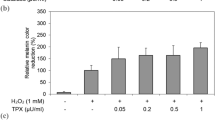Summary
Glutathione has important functions in the process leading to the complete neoplastic transformation of the primary cells in experimental carcinogenesis. This study was made to determine the tissue glutathione levels in the human skin carcinomas. The statistical average of glutathione values were measured by the DTNB method as 0.915 ± 0.073 mg/g wet weight in test group and 0.126 ± 0.008 mg/g wet weight in control group.
Zusammenfassung
Bei der experimentellen Carzinogenesis hat Glutathion wichtige Funktionen während der kompletten neoplastischen Transformation der Primär-Zellen. Diese Studie wurde durchgeführt, um die Gewebeglutathion-Werte in Hautcarcinomen des Menschen zu bestimmen. Der statistische Durchschnitt der nach der DTNB-Methode gefundenen Werte vom Gewebeglutathion wurde bei der Testgruppe mit 0.915 ± 0.073 mg/g Feuchtgewicht und bei der Kontrollgruppe mit 0.126 ± 0.008 mg/g Feuchtgewicht festgestellt.
Similar content being viewed by others
References
Calcutt, G., Doxey, D., Coates, J.: Further studies of the effects of chemical carcinogens upon the -SH levels of target and non-target tissues. Brith. J. Canc.15, 149–156 (1961)
Calcutt, G., Connors, T. A.: Tumour sulphydryl levels and sensitivity to the nitrogen mustard Merophan. Biochem. Pharmacol.12, 839–845 (1963)
Calcutt, G.: The sulphydryl groups of some normal tissues and some animal tumours. Brith. J. Canc.18, 197–207 (1964)
Crabtree, H. G.: Some effects of aromatic hydrocarbons on sulphur metabolism and tumour induction in mice. Canc. Res.6, 553–559 (1946)
Ellman, G. L.: Tissue sulphydryl groups. Arch. Biochem. Biophys.82, 70–77 (1959)
Hosoda, S., Nakamura, W.: Role of glutathione in regulation of hexose monophosphate pathway in Ehrlich ascites tumour cells. Biochim. Biophys. Acta222, 53–64 (1970)
Révész, L., Bergstrand, H., Modig, H.: Intrinsic non-protein sulphydryl levels and cellular radiosensitivity. Nature198, 1275–1277 (1963)
Sweeney, M. J., Ashmore, J., Morris, H. P., Weber, G.: Comparative biochemistry of hepatomas 4. Isotope studies of glucose and fructose metabolism in liver tumours of different growth rates. Canc. Res.23, 995–1002 (1963)
Warburg, O.: On the origine of cancer cells. Science123, 309–314 (1956)
Weber, G.: Carbohydrate metabolism in cancer cells and the molecular correlation concept. Naturwissenschaften55, 418–429 (1968)
Willis, R. A.: Pathology of tumours. Fourth Ed. pp. 125–144 London: Butterworths 1967
Author information
Authors and Affiliations
Rights and permissions
About this article
Cite this article
Engin, A. Glutathione content of human skin carcinomas. Arch. Derm. Res. 257, 53–55 (1976). https://doi.org/10.1007/BF00569113
Received:
Issue Date:
DOI: https://doi.org/10.1007/BF00569113




